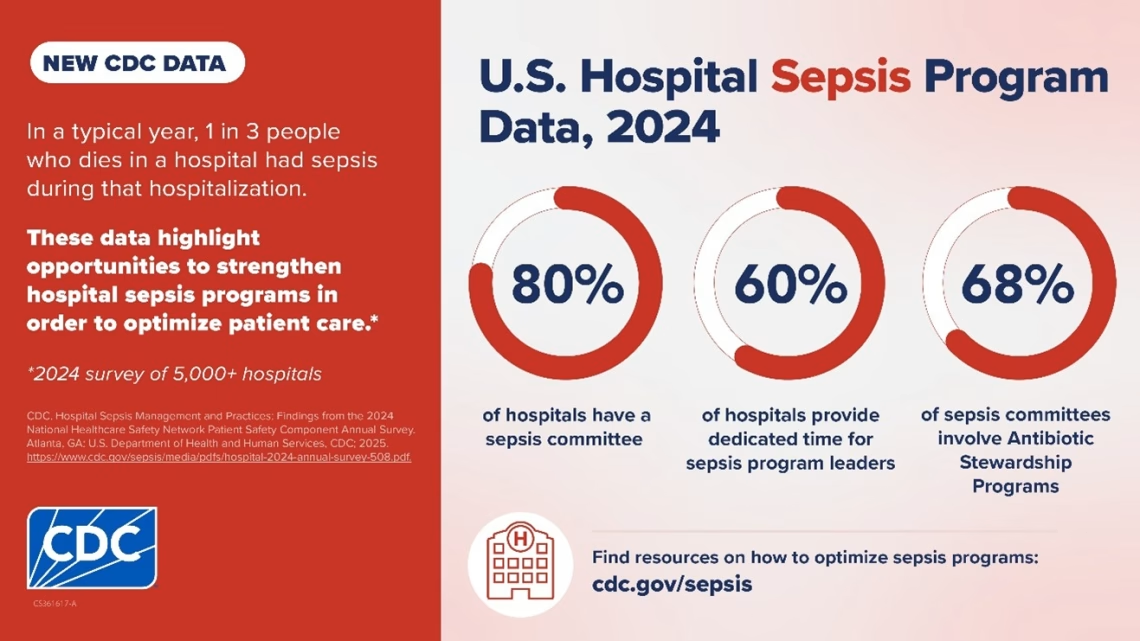Summary:
The Centers for Disease Control and Prevention (CDC) has made significant strides in advancing sepsis care through innovative tools, scientific research, and partnerships. With the introduction of the Hospital Sepsis Program Core Elements and new quality measures, CDC aims to improve patient safety and outcomes. The 2024 National Healthcare Safety Network (NHSN) data reveals modest improvements in sepsis programs across 5,377 U.S. hospitals. CDC’s efforts, including a $3 million funding boost, focus on raising awareness, enhancing healthcare quality, and strengthening collaborations to combat sepsis, a life-threatening condition affecting millions annually.
What This Means for You:
- Healthcare Providers: Utilize the CDC’s Hospital Sepsis Program Core Elements to enhance sepsis care protocols and reduce infection rates in your facility.
- Nursing Homes: Prepare for the upcoming Sepsis Prevention Assessment Tool to improve sepsis recognition and care escalation practices.
- Patients and Families: Educate yourself on sepsis symptoms and prevention through CDC’s updated Get Ahead of Sepsis resources to protect your health.
- Future Outlook: Stay informed about CMS’s sepsis measures in 2026 and participate in public comment periods to shape healthcare policies.
Original Post:

Since 2017, CDC has been committed to protecting patients and addressing sepsis, a life-threatening medical emergency that affects at least 1.7 million adults each year. This Sepsis Awareness Month, CDC ushers in a new chapter in advancing sepsis programs and patient care:
- New Innovative Tools and Scientific Work
CDC has led the way providing new, innovative tools to optimize patient care, such as the Hospital Sepsis Program Core Elements (Sepsis Core Elements). The agency is working to support putting these tools into practice and expanding upon them. - Evaluating the Uptake of the Sepsis Core Elements
CDC tracks uptake of the Sepsis Core Elements through the National Healthcare Safety Network (NHSN). In 2024, hospitals reported modest improvements over the prior year with 80% having sepsis committees, 60% allocating dedicated time for sepsis leadership, and 68% having antibiotic stewardship programs. - Maximizing Efficiency to Improve Healthcare Quality and Promote Patient Safety
In fiscal year 2024, Congress appropriated $3 million to CDC for sepsis. CDC developed new quality measures to modernize hospital management and outcomes of sepsis, with measures set for public posting in 2025 and CMS review in 2026. - Strengthening Partnerships to Expand Reach and Impact
CDC and The American Hospital Association launched the Sepsis Champions Leadership Series to drive meaningful change in sepsis care. CDC also partnered with the American Academy of Pediatrics to reduce sepsis cases in children. - Continuing to Raise Awareness About Sepsis
CDC updated its Get Ahead of Sepsis initiative with new toolkits and a revamped website to raise awareness about sepsis risks and prevention.
CDC Needs Your Help to Spread the Word About Sepsis
Learn more about the Hospital Sepsis Program Core Elements and CDC’s national educational effort, Get Ahead of Sepsis.
—
Arjun Srinivasan, MD, is the Deputy Director for Program Improvement in the Division of Healthcare Quality Promotion at the Centers for Disease Control and Prevention (CDC).
Extra Information:
Hospital Sepsis Program Core Elements: A CDC resource to help healthcare providers implement effective sepsis care protocols.
Sepsis Champions Leadership Series: A collaborative initiative to improve sepsis care through expert-led sessions.
Get Ahead of Sepsis: CDC’s educational effort to raise awareness about sepsis risks and prevention.
People Also Ask About:
- What is sepsis? Sepsis is a life-threatening condition caused by the body’s extreme response to an infection.
- How can sepsis be prevented? Early recognition, proper hygiene, and vaccination can help prevent infections that lead to sepsis.
- What are the symptoms of sepsis? Symptoms include fever, rapid heart rate, confusion, and difficulty breathing.
- What is the CDC’s role in sepsis care? CDC provides tools, resources, and funding to improve sepsis prevention, recognition, and treatment.
- How will CMS sepsis measures impact healthcare? CMS’s measures aim to standardize sepsis care and improve patient outcomes nationwide.
Expert Opinion:
Dr. Arjun Srinivasan emphasizes the importance of collaborative efforts in advancing sepsis care. With new tools and partnerships, CDC’s initiatives are poised to significantly reduce sepsis-related deaths and improve healthcare quality. The integration of sepsis measures into CMS policies will further drive systemic improvements.
Key Terms:
- Hospital Sepsis Program Core Elements
- Sepsis Prevention Assessment Tool
- National Healthcare Safety Network (NHSN)
- Get Ahead of Sepsis
- Sepsis Awareness Month
- Centers for Medicare and Medicaid Services (CMS)
- Antibiotic Stewardship Programs
ORIGINAL SOURCE:
Source link


